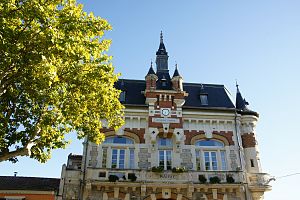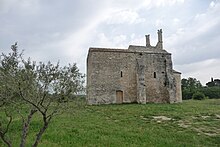Jonquières-Saint-Vincent
| Jonquières-Saint-Vincent | ||
|---|---|---|

|
|
|
| region | Occitania | |
| Department | Gard | |
| Arrondissement | Nîmes | |
| Canton | Beaucaire | |
| Community association | Beaucaire-Terre d'Argence | |
| Coordinates | 43 ° 50 ′ N , 4 ° 34 ′ E | |
| height | 13-81 m | |
| surface | 21.32 km 2 | |
| Residents | 3,779 (January 1, 2017) | |
| Population density | 177 inhabitants / km 2 | |
| Post Code | 30300 | |
| INSEE code | 30135 | |
| Website | jonquieres-st-vincent.com | |
 Mairie Jonquières-Saint-Vincent |
||
Jonquières-Saint-Vincent is a French commune with 3779 inhabitants (as of January 1, 2017) in the Gard department in the Occitanie region .
geography
Jonquières-Saint-Vincent is located 23 kilometers southwest of Avignon , 18 kilometers northwest of Arles and 16 kilometers east of Nîmes . The place is located west of the Rhone .
The border with the neighboring municipality of Redessan is roughly the linguistic border between the dialects of Provençal and Languedocian .
The neighboring municipalities of Jonquières-Saint-Vincent are Meynes in the north, Montfrin in the north, Comps in the northeast, Beaucaire in the east and south and Redessan in the west.
etymology
The place was first mentioned in 825 under the name Juncariae . In the early 13th century it appeared under the name Castrum Jonquieris. In 1789 the community was initially named Vincent-du-Gard . It was called Jonquières between 1793 and 1801, and has had its current name since 1801. This existed for a long time in the variants Jonquières et Saint-Vincent , Jonquières-et-Saint-Vincent and Jonquières-Saint-Vincent . On August 29, 1960, the municipality was finally called Jonquières-Saint-Vincent .
history
The region was originally covered by thick forests and swamps. Traces of people can already be found from the Paleolithic Age . Tools from the period between 25,000 and 10,000 BC, found in the Campuget lowland west of the Jonquières-Saint-Vincent train station, attest to the presence of man. In the Quartier des Lones , a neighborhood in the west of the resort, such discoveries have also been made. In 1961, three skeletons and objects from the Bronze Age were found in a cave . During the Roman period, some trade routes ran here, especially in an east-west direction. When Caesar settled the sixth legion near Arles in 47 BC , the legionaries brought with them knowledge of viticulture and thus promoted wine production. After the end of the Roman period who ruled Visigoths in Provence . They were in conflict with the Franks . Nevertheless, peace in the region remained largely intact until the 8th century. When the Moors invaded the south of France in 711, they caused great damage in Jonquières-Saint-Vincent. In 734, the Franks succeeded in conquering Nîmes and thus re-established a clear rulership in the region. In 1214 Raimund VI lost . , Count of Toulouse , the seigneurie to Simon de Montfort . In April 1229, the Count of Toulouse, who in the meantime reigned supreme, signed a treaty by which the Seigneurie fell to the Kingdom of France. In the Middle Ages there was a small fortress where the residents sought refuge in the event of war. In 1311 King Philip IV donated the castle of Jonquières, the village of Saint-Vincent and the parish of Saint-Laurent to his adviser Guillaume de Nogaret . The Grand Mas , which was destroyed in 1953, and a castle that existed until the 19th century date from this period . Agriculture and especially viticulture played an important role in the Middle Ages. The regional wine was mentioned in 1590 by the scientist Olivier de Serres . After an extreme winter in 1709, the vines were renewed, but in lower quality. Jonquières and Saint-Vincent have been one municipality since the revolution . In the 19th century, the marshes were drained and the community was connected to the railway (line La Grand-Combe - Beaucaire). In 1903 the community received its current Mairie . On July 1, 1909, the community was connected to the power supply; In 1933 the Mairie received a telephone. In 1924 a wine cooperative was established , and in 1934 a market hall.
Population development
| year | 1962 | 1968 | 1975 | 1982 | 1990 | 1999 | 2008 | 2017 |
| Residents | 1311 | 1445 | 1499 | 1825 | 2260 | 2745 | 3042 | 3779 |
Culture and sights
- The Grand Mas , an old farm from the 15th century, is located in the center of the village
- The Mairie (Town Hall) from 1903
- Remains of two mills from 1795
- Market hall from 1934
- Lavoir (wash house) from 1896
Via Domitia
The Via Domitia was a Roman road built between 120 and 118 BC. It led from the Alps along the Mediterranean Sea to the Pyrenees and was intended to serve as a connection between the newly conquered Roman territory and the capital Rome . Dealers in particular benefited from the new road. Each mile was marked with a miliarium , two of which can be found in Jonquières-Saint-Vincent (they are now in the Saint-Laurent chapel ). They date from the time of Emperor Claudius and point to a renewal of the street during his reign. The road runs south of today's town and crosses the municipality over a length of about five kilometers.
Churches
For a long time, the community was dependent on both the Archdiocese of Arles and the Diocese of Nîmes and had tax obligations towards both.
Around the year 1000, the Saint-Laurent chapel was built as a parish church for the village. Its interior measured twelve by four meters. In the choir of the chapel there are two Roman miliaria from the 1st century AD. After the hamlet where the chapel was located was abandoned, it fell into disrepair over time. Nevertheless, restorations were made to it again and again. In 1818 the parish priest took responsibility for restoring the chapel and the main church of Saint-Michel . However, conflicts arose and ultimately a fight, so that the pastor had to be replaced in 1819. It was not until 1821 that the parish received a new pastor. The Saint-Laurent chapel has been a monument historique since December 24, 1926 . It corresponds to the Carolingian architectural style. There are three round arches in the roof above the apse . The main room of the church has four small arched windows. The cross of the former cemetery is located in the immediate vicinity of the chapel.
The Saint-Michel church was built outside the walls of the village in the 13th century. Possibly it followed an older Carolingian style building. The church was easier for people to reach than the Saint-Laurent chapel, and so Saint-Michel eventually became a parish church. In 1819 the church was found to be too small. Demolition began on July 3, 1844, and was then re-inaugurated in September 1845. The current church is laid out in a cross shape. Five rose windows let light into the building. There are a total of three altars in the church, the facade is adorned by a gable. The Saint-Michel clock tower was renovated in 1995.
Town twinning
The municipalities of Jonquières-Saint-Vincent and Vezza d'Alba (Italy) have been twinned on July 12, 1974 . The partnership committee was founded on September 8, 1973.
Web links
Individual evidence
- ↑ a b c d History of the place ( Memento of the original from October 4, 2011 in the Internet Archive ) Info: The archive link was inserted automatically and has not yet been checked. Please check the original and archive link according to the instructions and then remove this notice.
- ↑ The community on annuaire-mairie.fr
- ↑ Sights and cultural heritage ( Memento of the original from October 3, 2011 in the Internet Archive ) Info: The archive link has been inserted automatically and has not yet been checked. Please check the original and archive link according to the instructions and then remove this notice.
- ↑ Sister- city partnership ( Memento of the original from October 3, 2011 in the Internet Archive ) Info: The archive link was inserted automatically and has not yet been checked. Please check the original and archive link according to the instructions and then remove this notice. , accessed September 8, 2011


